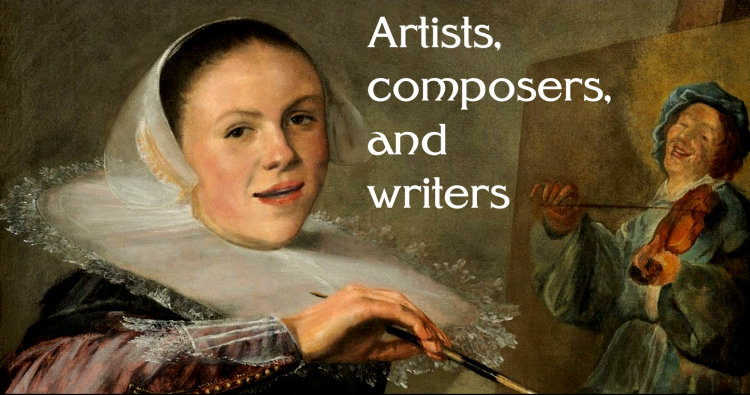12. Blue Notes, Black Ink
The two classes on the arts in America so far have avoided consideration of the Black contributions to American
culture, except for some brief references to jazz. This final class will attempt to redress this, by looking in
some detail at the surge of poetry, music, and the visual arts in the Harlem Renaissance of the 1920s and 1930s.
In the second hour, we shall extend this to the present day, by sampling three recent or contemporary Black
artists who come from different countries and work in different fields: the poet Derek Walcott, the sculptor Yinka
Shonibare, and the singer-songwriter Youssour N'Dour.
Arguably, the dominant art form of the Harlem Renaissance was poetry. I have therefor prepared a small anthology,
including several extra poems not read in class; you can access them at Texts
above. rb.
The script, videos, and images will be posted immediately after class.
Here are brief bios of the artists and poets considered in the class, listed in chronological order of birth.
You can access all biographies via the BIOS link on the syllabus page.
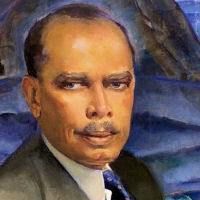 |
James Weldon Johnson, 1871–1938. American poet, educator, and activist.
A major figure in the Harlem Renaissance, he is remembered as author of the song "Lift Ev'ry Voice and Sing," sometimes known as the "Negro National Anthem." Johnson was appointed an American Ambassador by Theodore Roosevelt, and later became leader of the NAACP.
|
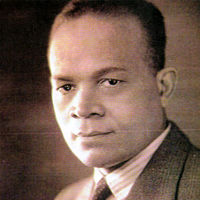 |
Joel A. Rogers, 1880–1966. Jamaican American writer.
Very light skinned, Rogers experienced little racial prejudice until he settled in the US at age 26. His most influential work was The World's Greatest Men of African Descent (1931), which identified many notable people previously considered white as descendants of African forebears.
|
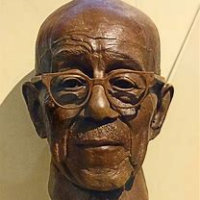 |
James Hubert "Eubie" Blake, 1887–1983. American musician.
Blake was born in Baltimore to former slaves; his father was a stevedore. He started "foolin' around" on a music-store organ at age 5, and the owner persuaded his mother to buy him an instrument; he was playing in a Baltimore bordello in his teens. As well as the composer of several standards, he is best known as the creator (with Noble Sissle) of the first Black musical Shuffle Along (1921).
|
 |
Sargent Johnson, 1888–1967. American sculptor.
Johnson was of mixed race, African American and Cherokee through his mother, Swedish through his father, though he himself identified as Black, and frequently addressed negro themes in a somewhat abstracted, early Modernist style.
|
 |
Noble Sissle, 1889–1975. American musician and lyricist.
Born in Indianapolis, Sissle served in WW1 as a member of the US Army Band credited with introducing syncopated music in to Europe. Around the same time, he met Eubie Blake. The two went into partnership after the war, creating songs such as "I'm just wind about Harry" and the first all-Black musical, Shuffle Along (1921).
|
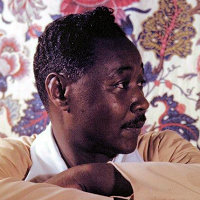 |
Claude McKay, 1890–1948. Jamaican American poet.
McKay originally came to the US to study agriculutre at Tuskegee, but he was more interested in writing. His poem "If We Must Die" electrified African Americans experiencing the racial persecution of 1919. McKay later became a Communist, and lived in Russia from 1922 to 1934.
|
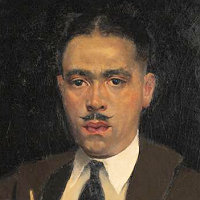 |
Archibald J. Motley, 1891–1981. American painter.
Motley was born in New Orleans, but studied in Chicago and lived there most of his life, reflecting the Harlem ideal of the :New Negro," but never actually living there. Of mixed race himself, he did not mingle easily with the Black community, and regarded painting partly as a way to better understand his own people.
|
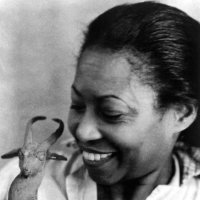 |
Augusta Savage, 1892–1962. American sculptor.
A leading sculptor of the Harlem Renaissance, Savage was one of only two African Americans commissioned to create works for the 1939 New York World's Fair. The result, Lift Every Voice and Sing, showing a group of Black singers standing like the strings of a harp, was widely reproduced.
|
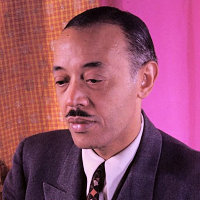 |
William Grant Still, 1895–1978. American composer.
Although associated with Langston Hughes and other luminaries of the Harlem Renaissance, Still used forms and forces associated with classical music. His Afro-American Symphony (1931) was the first large-scale work by a Black composer performed by a major orchestra (Rochester), and his opera Troubled Island was the first by any American to be performed by the New York City Opera.
|
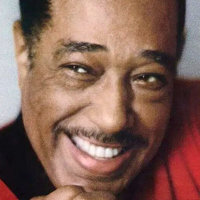 |
Edward Kennedy "Duke" Ellington, 1899–1974. American musician.
"Born and raised in Washington, D.C., Ellington was based in New York City from the mid-1920s and gained a national profile through his orchestra's appearances at the Cotton Club in Harlem. Writing or collaborating on more than a thousand pieces, Ellington was known for his inventive use of the orchestra, or big band, as well as for his eloquence and charisma." [Wikipedia]
|
 |
Aaron Douglas, 1899–1979. American painter and illustrator.
Born in Kansas and a graduate of the University of Nebraska, Douglas was recruited to New York by the editor of the Black periodical Opportunity to serve as the painter of the Harlem Renaissance. Unlike many of his contemporaries, he was able to obtain fellowships and commissions which sustained him in a long career. His works seem composed of flat transparent layers overlaid in depth.
|
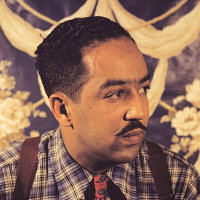 |
Langston Hughes, 1901–67. American poet and playwright.
Sometimes referred to as "the poet laureate of Harlem," Hughes was born in Missouri, but had an unsettled childhood, moving from place to place. He continued to travel (including to Africa, Europe, amd Russia) and work in odd jobs even after his first works were published in 1921. His 1926 collection The Weary Blues introduced a new genre of poetry in a vernacular idiom to a jazz beat.
|
 |
Richmond Barthé, 1901–88. American sculptor.
Associated with the Harlem Renaissance, Barthé specialized in Black subjects. He declared: "All my life I have been interested in trying to capture the spiritual quality I see and feel in people, and I feel that the human figure as God made it, is the best means of expressing this spirit in man." [Wikipedia]
|
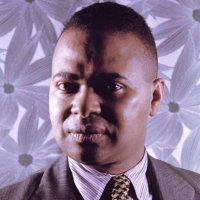 |
Countee Cullen, 1903–46. American poet.
Cullen was the adopted son of one of Harlem's leading ministers, and was educated at NYU and Harvard. In form, his poetry has a Keatsian elegance, though his subjects are drawn from the negro experience.
|
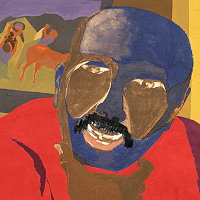 |
Jacob Lawrence, 1917–2000. American painter.
Lawrence gained national fame at the age of 23 with his 60-panel series depicting the Great Migration. He went on to paint several other series, with less specifically Black subjects but equal concern for ordinary people. His style is distinguished by bright colors and jagged shapes reflecting either the influence of Cubism or the rhythms of Harlem life.
|
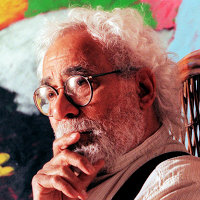 |
Robert Colescott, 1925–2009. American painter.
Born in California, Colescott studied partly at Berkeley, partly with Fernand Léger in Paris. His is known for his exuberant and often satirical works, many of which are parodies of old masters, representing the position of Black people within American society.
|
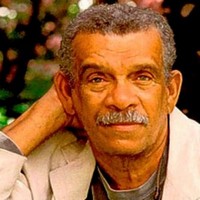 |
Derek Walcott, 1930–2017. Saint Lucian poet, playwright, and painter.
Winner of the 1992 Nobel prize in literature, Walcott was a world traveler who kept returning to his birthplace of Saint Lucia, infusing his work with Caribbean history, light, and color. His 1990 epic Omeros attempts nothing less than an overview of the African diaspora in the manner of Homer.
|
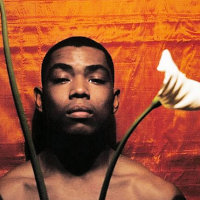 |
Alvin Ailey, 1931–89. American choreographer.
Born into poverty in Depression-era Texas, Ailey nonetheless established himself as one of the leading Black dancers in America, performing with May Angelou, Lester Horton, George Balanchine, and on Broadway. He founded the Alvin Ailey American Dance Theatre in 1958 to give a dance presence to Black experience, and choreographed Revelations, his signature work, in 1960.
|
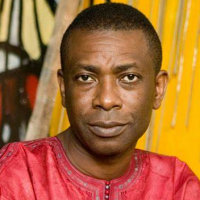 |
Youssou N’Dour, 1959– . Senegalese singer-songwriter.
N'Dour's numerous CDs and videos rocketed him to the top of the World Music scene in the 1990s, performing all over the world in a mixture of Wolof, English, French, and other languages. In addition, he has played an active role as a political and social activist, serving both as a UN cultural ambassador and as a minister for his own country, Senegal.
|
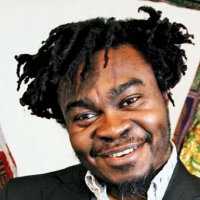 |
Yinka Shonibare, 1962– . Nigerian-British artist.
Born in London to Nigerian parents, Shonibare went back to Africa with them as a child, before returning to England in his late teens. He is famous for his use of highly colored African fabrics for his sculptures and assemblages, that frequent explore themes of colonialism and subjugation. Paralyzed on one side of his body through illness, he uses assistants to complete the work that he designs.
|
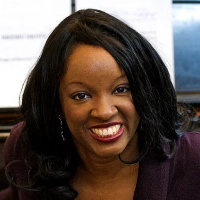 |
Nkeiru Okoye, 1972– . American composer.
Born in New York, Okoye has an African American mother and a Nigerian father, and he childhood was divided between both countries. No stranger to the large stage, she has writen an opera on the life of Harriet Tubman, and several projects commissioned by US symphony orchestras.
|
 |
Abdoulaye Diarrassouba ("Aboudia"), 1983– . Ivorian painter.
Aboudia divides his time between Brooklyn and Abidjan, painting in a style that marries street graffiti to Abstract Expressionism.
|
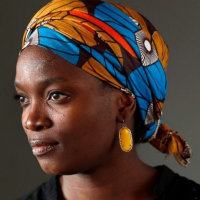 |
Njideka Akunyili Crosby, 1983– . Nigerian American painter.
Crosby is a Nigerian-born visual artist working in Los Angeles. Through her art Akunyili Crosby "negotiates the cultural terrain between her adopted home in America and her native Nigeria, creating collage and photo transfer-based paintings that expose the challenges of occupying these two worlds" [Smithsonian citation]. She was awarded a MacArthur Foundation "genius" grant in 2017.
|
 |
Amaoko Boafo, 1984– . Ghanian painter.
Training first in Accra and then in Vienna, where he still lives, Boafo has pursued as meteoric career as a figure painter and portraitist, with one of his works from 2018 selling for $3.4 million in auction in Hong Kong.
|






















































